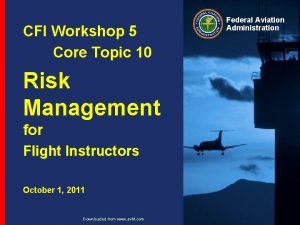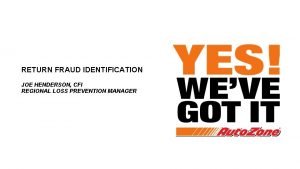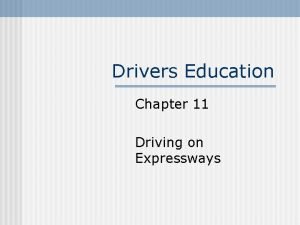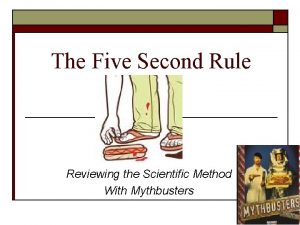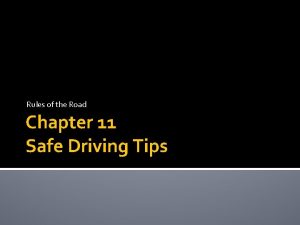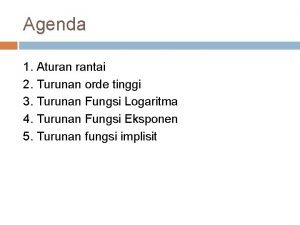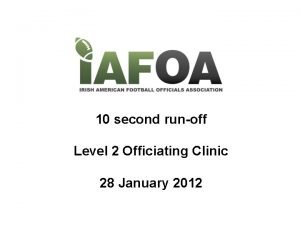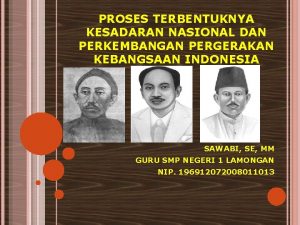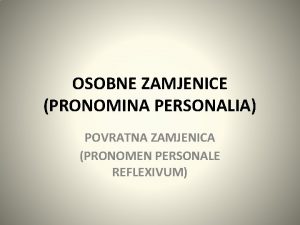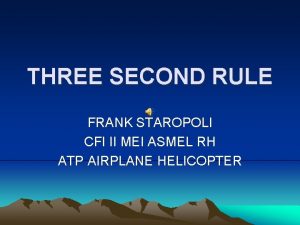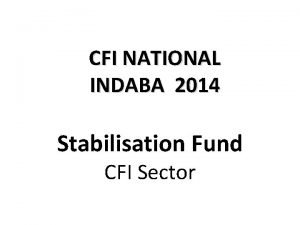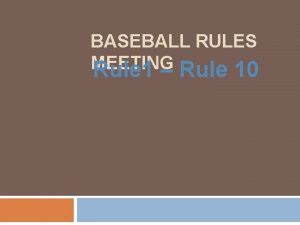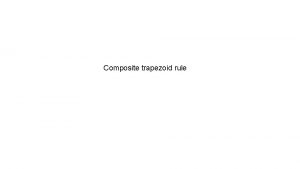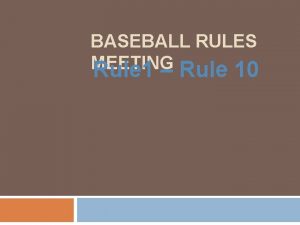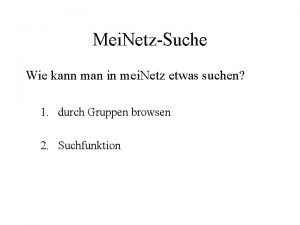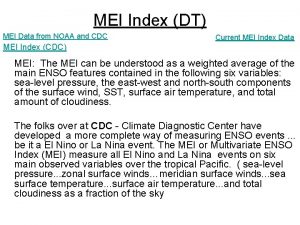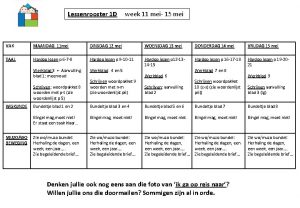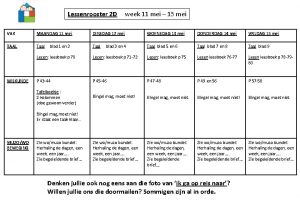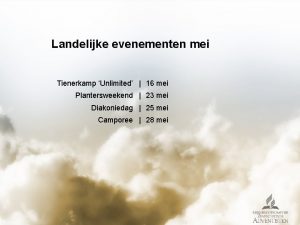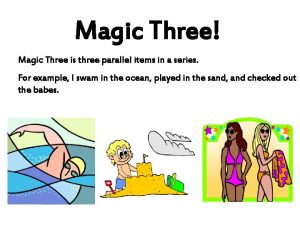THREE SECOND RULE FRANK STAROPOLI CFI II MEI

























- Slides: 25

THREE SECOND RULE FRANK STAROPOLI CFI II MEI ASMEL RH ATP AIRPLANE HELICOPTER

SCANNING • This presentation will hopefully help you, THE PILOT IN COMMAND, to think about extending your skills in VFR and IMC conditions. • THREE SECONDS OR LESS TO INCORPORATE YOUR SCANNING INTO A SAFER FLIGHT!!!!

How long would you take your eyes off of the road while driving at 60 MPH?


–For every 10 MPH, the general rule for following the auto in front of you is one car length or approximately 2 to 3 seconds to stop safely.

SCENERIO 1 • You are driving 70 MPH on a major road. Speeding? Possibly. • Your cell phone calls you. • NEED to answer the phone? ? ? • You NEED? ? to text message. • You NEED? ? to dial a number. • You NEED? ? to change the radio, CD. • You NEED? ? to take care of a back seat situation.

DO YOU NEED TO? ? ? All of these situations are happening every day as one drives their auto. • Are these the only situations? • Can you name a few more that you know about? • What do these scenarios suggest that the driver is doing or going to do? • Might we accomplish the above safely?

EYES ON THE ROAD • If a driver takes ones eyes off of the road for approximately 2 to 3 seconds, the possibility or odds for a major problem increase dramatically. • Traveling at 10 MPH you would need 1 car length to safely stop without an incident. • WHAT DOES THIS HAVE TO DO WITH FLYING?

SCENERIO 2 • You are flying IFR/VFR. • Need to change a COM/NAV frequency. • Need to pick up the pad/pencil you dropped. • Need to copy a clearance. • Those back seat situations. • Where did I put that emergency checklist? • Need to change fuel tanks.





All of these situations are happening every day as one flies their airplane or helicopter. • Are these the only situations? • Can you name a few more that you know about? • What do these scenarios suggest that the pilot is doing or going to do? • Might we accomplish the above safely?

SO WHAT AM I SUGGESTING? • FLY THE AIRPLANE or HELICOPTER • . • FLY THE AIRPLANE or HELICOPTER.

OPTIONS • Do you have an Autopilot? • NO!!! THEN…. • I am suggesting that you take care of the situation that you are involved in for no more than 3 seconds at a time • FLY THE AIRCRAFT

FLY THE AIRCRAFT • HOW DOES ONE DO THIS SAFELY?

3 SECONDS • No more than 3 seconds to accomplish A task before checking the flight instruments/ traffic. • SAFE? • WHICH INSTRUMENTS? ? • HEADING >>DG • ALTIMETER • ATTITUDE INDICATOR

3 SECONDS • 3 Seconds in a standard rate turn will give you approximately a 10 degree change in heading if you are not paying attention. • SAFE? • TRY 6 SECONDS— 20 degree or more. • PROBABLY NOT A STANDARD RATE TURN ANYMORE!!!!!! • 3 seconds at 500 ft/min will give you approximately 25 to 50 foot altitude change.


CFIS, CFIIS, STUDENTS • What about any pilot? • The 3 second rule is a SUGGESTION designed to enhance SAFETY! • EFFICIENT? • YOUR CALL!!!!!! • TRY IT. YOU MIGHT LIKE IT.

ANOTHER SUGGESTION • Students, pilots!!!! • Having a hard time landing? • A few of our pilot brethren have on occasion have had hard landings usually after flaring low or high, poor timing. • Have you?

3 SECOND RULE • Airspeed slightly above 1. 2 x Vso ON APPROACH. MAINTAIN A/S • FLARE. • Place the aircraft in the landing configuration. • This usually requires a slightly high nose attitude to prevent the nose wheel from touching first. • YOU WILL FLOAT. • If A/S IS TOO LOW, THERE WILL BE NO FLOATING.

3 SECOND RULE • COUNT 3 SECONDS. IF THE MAINS HAVEN’T TOUCHED. • ADD 100 RPM OR 1” MP • IF THE NOSE RISES, YOU ADDED TOO MUCH THROTTLE, EASE OFF the throttle. • Maintain landing configuration. • Do not pull on the yoke more than necessary. • (nose rises out of landing configuration) • SQUEAK!! • REQUIRES A LONGER RUNWAY.

ANY QUESTIONS? ? • FRANK STAROPOLI • CFI II MEI • fstar@starman 1. com
 Frank staropoli
Frank staropoli Cfi 1
Cfi 1 I am safe checklist
I am safe checklist Jmu cfi
Jmu cfi Ducreux cfi
Ducreux cfi Cfi loss prevention
Cfi loss prevention Cfi defence
Cfi defence Three second rule driving
Three second rule driving Frank william abagnale
Frank william abagnale 27 miles per gallon into kilometers per liter
27 miles per gallon into kilometers per liter 5 second rule science experiment
5 second rule science experiment Two-second rule
Two-second rule Turunan orde tinggi
Turunan orde tinggi False start 10 second runoff
False start 10 second runoff Fluorite structure
Fluorite structure First second and third normal form in dbms
First second and third normal form in dbms Mei bai
Mei bai Gerindo berdiri di jakarta 24 mei 1937 akibat dari
Gerindo berdiri di jakarta 24 mei 1937 akibat dari Ego mei mihi me me
Ego mei mihi me me Organisasi profesi humas di dalam negeri
Organisasi profesi humas di dalam negeri Reformdjp/quiz/kuis-mini-april
Reformdjp/quiz/kuis-mini-april Mei wants to solve the inequality
Mei wants to solve the inequality Oe bgk mei
Oe bgk mei Zhe yi sheng zui mei de zhu fu lyrics
Zhe yi sheng zui mei de zhu fu lyrics Ego tu is ea id
Ego tu is ea id Kohlapso
Kohlapso


